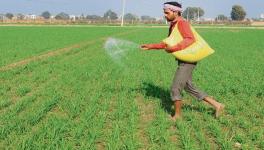How to Create a Farm Crisis?
Farm Crisis, Image Courtesy: wikipmedia.org
The recent revelation that the co-operatives banks are still sitting on old currency worth Rs. 9,000 crores, gives us a different perspective on the steep fall in agricultural prices and the crisis of the farmers. It points to the culpability of central government and RBI in the farm crisis, by depriving the rural areas of much needed liquidity on one side, and institutional credit on the other side.
If we remember, when the prime minister announced the decision to demonetize on the 8th November last year, citizens were allowed to deposit the old 500 and 1000 rupee notes in co-operative banks. But, 4 days in to the demonetisation exercise, government announced that co-operatives will no longer be allowed to take in deposits in old currency. The reason - government’s suspicion that black money in the form of old currency notes was being deposited in the co-operative banks. By then, the co-operative banks had already taken in old currency totaling Rs. 9,000 crores.
RBI put the co-operative banks in a fix by refusing to exchange these 9000 crore of old notes - even though this amount came in to the banks in the first four days when they were allowed to take them in. Subsequently these banks went to the Supreme Court, which ordered NABARD (National Bank for Agriculture and Rural Development) to inspect the implementation of KYC norms of co-operative banks and submit a report to the RBI. Only after this would RBI exchange the banks’ old notes.
It is two months since NABARD has submitted it’s report; the RBI is just sitting on it. If the report has indeed found any irregularities in the co-operative banks, RBI has not initiated any action. Going by the press reports, NABARD has not found any irregularities, but RBI still refused to exchange the notes. Only this week, when media started reporting on this, has the central bank agreed to exchange the notes of co-operative banks.
The result of RBI’s refusal was that co-operatives banks were sitting on RS. 9,000 crore of useless cash, affecting their ability to lend to the farmers. These banks are responsible for a significant share of credit disbursal (17%) in rural areas. In states like Maharashtra, where distressed famers were agitating for loans waivers, their share in agricultural credit is much higher, possibly close to 50%.
How much money has come back to RBI?
This whole episode with Co-Operative banks, also brings us back to the question of ‘how much money has come back to the RBI?’. Is RBI refusing to accept the old currency of the co-operative banks because, then it will have to declare the total old currency that has come back to it?
It is 7 months since demonetisation. The RBI and the government refuse to release the numbers of how much of the demonetised notes have come to the RBI. Finance Minister, Mr. Jaitly claimed in the parliament that RBI is still counting and tallying the notes, while the banks say that they have counted the currency and submitted the full accounts on 31st of December. For a country that prides itself on its discovery of the number system and zero, this is indeed very poor arithmetic.
After claiming that Rs. 3 to 4 lakh crores were not going to come back to RBI, government probably felt it is prudent not to publish the figures to the contrary. December 10th was the last time, when RBI declared the total currency that has come back in to the system. By then, 80% (12.4 lakh crore) of the money had already come back, with still 20 days to go. There have been reports that 97% of the old demonetised notes have been deposited to the RBI. If now added the above Rs. 9,000 crores with the co-operative banks, it appears that almost 100% money has come to the system.
By refusing to act on the NABARD report, RBI and the government can have the excuse of counting and tallying the notes forever, hoping that the country will soon forgets the whole fiasco.
But, as the current agrarian crisis shows, it is difficult to forget when demonetisation’s effects continue to haunt the economy. As the latest data shows, RBI is yet to replace 20% of the Rs. 15 lakh crore that was demonetised. People are feeling the pinch of Rs. 3 lakh crore of currency that is missing from circulation, particularly in rural areas where there is still a substantial shortage of cash. This lack of liquidity has also been a major reason behind the agricultural price crash.
It is time the central government deals with the consequences of it’s actions and helps out the farmers who are suffering from them. It is time for it to implement farm loan waiver and viable Minimum Support Price for the farmers, instead of putting the burden on the state governments.
Disclaimer: The views expressed here are the author's personal views, and do not necessarily represent the views of Newsclick
Get the latest reports & analysis with people's perspective on Protests, movements & deep analytical videos, discussions of the current affairs in your Telegram app. Subscribe to NewsClick's Telegram channel & get Real-Time updates on stories, as they get published on our website.
























